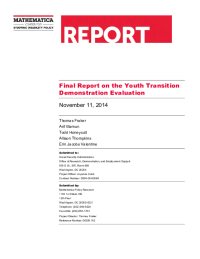Final Report on the Youth Transition Demonstration Evaluation
Youth with disabilities often have particularly difficult transitions to adulthood. In addition to the issues facing all transition-age youth, those with disabilities face special challenges related to health, social isolation, service needs, and the potential loss of benefits. These complicate their planning for education and work, which may result in poor education and employment outcomes and a possible lifetime of dependence on benefits. Cash assistance provided to these youth through the Supplemental Security Income (SSI) and Social Security Disability Insurance (DI) programs, administered by the Social Security Administration (SSA), has increased by 55 percent since 2000. Benefits totaled more than $10 billion in 2012, leading to growing concerns about costs.
Recognizing the importance of helping young people with disabilities achieve their full economic potential at this critical juncture in their lives, SSA undertook the Youth Transition Demonstration (YTD) evaluation. The purpose of the evaluation was to identify and test the most promising service strategies, combined with SSA waivers of certain program rules to enhance work incentives, for helping youth with disabilities maximize their economic self-sufficiency as they transition to adulthood. SSA selected six project sites into the evaluation based on their adoption of promising strategies to support youth with disabilities and on their capacity and willingness to support evaluation activities. The target population for YTD was youth ages 14 to 25 who were receiving SSA disability benefits or were at high risk of receiving such benefits in the future.
Under contract to SSA, Mathematica Policy Research and its partners, MDRC and TransCen, Inc., conducted a rigorous evaluation of the YTD projects using a random assignment evaluation design. Across the six project sites, more than 5,000 youth enrolled in the evaluation and were randomly assigned to either a treatment group that could participate in the YTD projects or a control group that could not. Mathematica and its partners in the evaluation conducted site-specific analysis to assess the impacts of the interventions one year and three years after youth enrolled in the evaluation. The one-year analysis found that all six projects had positive and statistically significant impacts on the receipt of employment-promoting services by youth, but only three projects had positive impacts on employment. This report presents estimates of the impacts of the YTD projects on paid employment and earnings, total income from earnings and benefits, participation in productive activities, contact with the justice system, and self-determination. It also offers estimates of each project’s average cost per participant.






